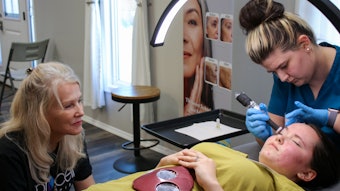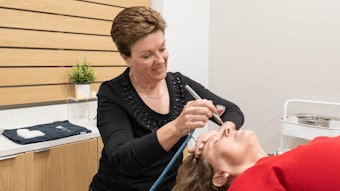Everyone knows that the most crucial challenge in skin care is staffing. Business owners and managers need to consider the enormous impact that hiring decisions have on the long-term financial success of a commercial operation today, tomorrow and in years to come. Ask anyone who owns or operates an esthetic facility, and they will tell you that it is not easy to recruit the best people in this profession.
Finding a pearl
Most individuals charged with recruiting believe that it is extremely difficult to pinpoint instantly who the top job candidates are from a sea of self-proclaimed “A-list” talent, all of whom profess to be the best fit for the job. Due to the far-reaching effects of corporate downsizing, massive layoffs and the current economic environment, a new pool of intelligent high-wage earners is available to consider. However, although a candidate may interview well, the person may have very limited expertise, further complicating the hiring issue.
Clearly, no one in business these days can afford to hire unqualified professionals who become unproductive and unprofitable. New hires also have both an internal influence on pre-existing staff and an external influence on clients. The ability to identify candidates who communicate well and work collaboratively with others in the business enterprise is an important, non-negotiable skill for recruiters engaged in hiring only the best and the brightest.
When sifting through a towering stack of applications, follow seven breakthrough rules for high-stakes hiring to choose the best fit for the position, your team and your spa.
Create the best fit. Undeniably, great people are the backbone of any esthetic operation that bases its business transactions on extremely intimate one-on-one contact with the public. Sometimes it’s necessary to pass on a seemingly exceptional candidate with extensive knowledge and skills because the individual doesn’t fit in with your existing team. Fighting among co-workers is nonproductive and nonprofitable, and when employees do not get along, it costs owners clients and even valuable team members. Thus, before making any hiring decision, allow your employees to spend some time with the final candidates who are up for consideration. Encourage them to ask their own questions and report back to you with their thoughts and concerns.
Avoid being mystified. Take care not to fall into the trap set by charismatic job seekers. It’s easy to establish a rapport with a pleasant and friendly candidate who is interesting and conversationally stimulating. However, a pleasing personality may not get the job done. An interviewer easily can be swayed by an applicant and neglect to take into account how well suited the person really is for the position. It also is easy to favor an individual who appears to like and admire us. Most poor hiring choices can be avoided if recruiters understand some of the complexities involved in the hiring process, including the most common problems: poor planning, inadequate hiring criteria and hastiness to fill job openings with likable candidates. Always look beyond your initial contact with a candidate, and be aware that first impressions can be misleading and even may mask possible professional shortcomings.
Test a candidate’s skills. Utilize the working interview strategy to evaluate an applicant’s knowledge instead of conducting the traditional in-office interview. Give the person a tour of the facility to get an idea of how the skin care operation runs. Then wander into a treatment room and ask the job candidate to demonstrate some aspect of the service or to operate a certain piece of equipment that would be utilized on the job. Other candidates interviewing for positions in management or in retail should be asked to engage in a role-playing exercise to give the interviewer a sense of how they close a sale or display merchandise. Arrange a variety of mock activities in order to truly assess talent and skill. Make certain that the actions requested of the applicant represent functions that, if hired, actually would be performed on the job.
Identify superstar talent. When looking for new team members, be on the lookout for applicants with remarkable potential. These professionals often are more self-assured, learn quickly, possess good listening skills and are stimulated by new challenges. They also are suited to jobs that extend their learning curve and increase their earning potential, and they are famous for working long hours and seeking commission in lieu of conventional salaries. Don’t discount these candidates out of fear that they may be recruited by the competition. To determine if a candidate is a high performer, use appraisal methods to assess the person’s full potential with questions that elicit responses that reveal behaviors, attitudes and tendencies toward collaboration and policy compliance. For a less-skilled candidate who is highly motivated, you may choose to overlook inexperience in favor of an ambitious nature and an overall prospect of becoming highly successful. Additional attention and mentoring can encourage performance development. Just be certain to protect your facility by implementing a probationary period, should you choose to hire such a person.
Plan compensation carefully. Before beginning the hiring process, it is important to design a compensation package that works for all parties. If the job is based on commission, balance the expected income with the base salary. Add a percentage for the first three months to make your offer financially feasible. For example, an additional 20% of the earned commissions can be included for the first month, followed by 15% the second month and 10% the third month to financially assist the new employee. Once the person is working full time, the employer no longer needs to contribute.
Establish contractual agreements. It is important to create a contract for any new team member in order to protect the spa against the possibility of the person leaving to work for your competitor. Investing in the training and advancement of any new hired professional is always somewhat of a gamble. A contract provides all parties with a legal record of the employment details discussed, in addition to what was agreed upon verbally. You also may want to include a noncompete and/or confidentiality clause for certain job positions that are privy to confidential information, such as management team members. If applicable, the contract should stipulate the terms of the candidate’s probationary period and any other relevant employment factors.
Conduct orientation and training. When integrating your new employee into your facility, issue a copy of your policy manual and any hands-on procedures to review prior to the start date in order to prevent any misunderstandings. Insist on testing the employee’s skills progress. An examination promotes confidence in the new hire and will serve as a record that the person was trained appropriately for the position. Should the need ever arise to defend your training methods, a copy of the test can be produced on your behalf. Also, when training, avoid testing the new hire with any “trial-by-fire” tasks that create undue stress.
Hiring success
Following these rules can increase the success of the hiring process and minimize your chances of hiring an applicant who is not right for the job. It also may eliminate any misunderstandings or assumptions between yourself and a new employee.










